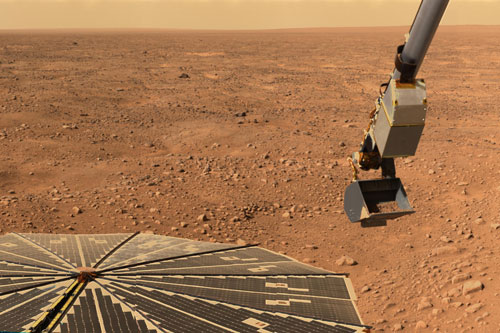
The soil on Mars may be more capable of supporting life than previously thought, a new study suggests.
Researchers have long suspected that the Martian surface is packed full of oxidizing compounds, which could make it difficult for complex molecules like organic chemicals — the building blocks of life as we know it — to exist. But the new study, which analyzed data gathered by NASA's Mars Phoenix Lander, suggests that's not the case.
"Although there may be some small amounts of oxidants in the soil, the bulk material is actually quite benign," said lead study author Richard Quinn of NASA's Ames Research Center and the SETI (Search for Extraterrestrial Intelligence) Institute in Mountain View, Calif. "It's very similar to moderate soils that we find on Earth."
Digging in the Martian dirt
Astrobiologists have long been interested in characterizing soils on Mars, to help determine whether life could ever have gotten a foothold on the Red Planet. [5 Bold Claims of Alien Life ]
NASA's $420 million Phoenix mission has given them a lot to ponder in this regard. The Phoenix lander touched down near the Martian north pole in late May 2008, then gathered a variety of observations for the next five months.
Phoenix is most famous for confirming the existence of water ice on Mars, but it also made a lot of interesting soil measurements. One of those was the Mars dirt's acidity, or pH, level.
Get the Space.com Newsletter
Breaking space news, the latest updates on rocket launches, skywatching events and more!
"People really didn't know what the pH was going to be," Quinn told SPACE.com. "A lot of people believed that the soils would be very acidic."
But just a month or so into its mission, Phoenix found that the dirt at its landing site was mildly basic, with a pH around 7.7. The lander also detected several chemicals that could serve as nutrients for life-forms, including magnesium, potassium and chloride.
These discoveries intrigued scientists, suggesting that Martian soil is perhaps more hospitable to microbial life than they had thought. And the new results provide further evidence along those lines.
Stable soil chemistry?
Phoenix made the pH and various other discoveries using its onboard wet chemistry laboratory (WCL). The lander scooped Martian dirt into cups of water brought from Earth, and the WCL instrument analyzed the resulting solution. [Infographic: Mars Landers and Rovers Since 1971]
Quinn and his colleagues studied the Phoenix data from 2008, focusing this time on measurements of Martian soils' oxidation-reduction potential. Oxidation refers to the stripping away of electrons. It's a destructive process that can tear up complex molecules like DNA, which is why people need antioxidants as part of a balanced diet.
Scientists had reason to think that Martian soil might be highly oxidizing, Quinn said. In the mid-1970s, for example, NASA's Viking landers mixed some organic compounds into Martian dirt, and the chemicals appeared to decompose.
And Phoenix itself detected a molecule called perchlorate, which under some conditions is a strong oxidizer. But the new results, reported last month in the journal Geophysical Research Letters, paint a rosier picture of Red Planet soil as far as habitability is concerned.
"When you look at the composite of all the material in there, and you measure the overall reactivity of that soil in solution, it's comparable to what you would find in terrestrial soils, Earth soils," Quinn said. "So it's not an extreme environment in that regard."
The results don't prove that Martian life exists or ever has existed. However, they and other recent finds — including evidence from the High Resolution Imaging Science Experiment (HiRISE) camera aboard NASA's Mars Reconnaissance Orbiter that liquid water may have flowed just beneath the Martian surface in the last year or so — are making scientists more and more hopeful.
"The evidence from the HiRISE team that there may be seasonal water flow at some locations, combined with this measurement that shows that when the soil is wetted it's actually not harsh conditions — it's very positive in terms of the potential for life to get a foothold," Quinn said.
You can follow SPACE.com senior writer Mike Wall on Twitter: @michaeldwall. Follow SPACE.com for the latest in space science and exploration news on Twitter @Spacedotcom and on Facebook.
Join our Space Forums to keep talking space on the latest missions, night sky and more! And if you have a news tip, correction or comment, let us know at: community@space.com.

Michael Wall is a Senior Space Writer with Space.com and joined the team in 2010. He primarily covers exoplanets, spaceflight and military space, but has been known to dabble in the space art beat. His book about the search for alien life, "Out There," was published on Nov. 13, 2018. Before becoming a science writer, Michael worked as a herpetologist and wildlife biologist. He has a Ph.D. in evolutionary biology from the University of Sydney, Australia, a bachelor's degree from the University of Arizona, and a graduate certificate in science writing from the University of California, Santa Cruz. To find out what his latest project is, you can follow Michael on Twitter.